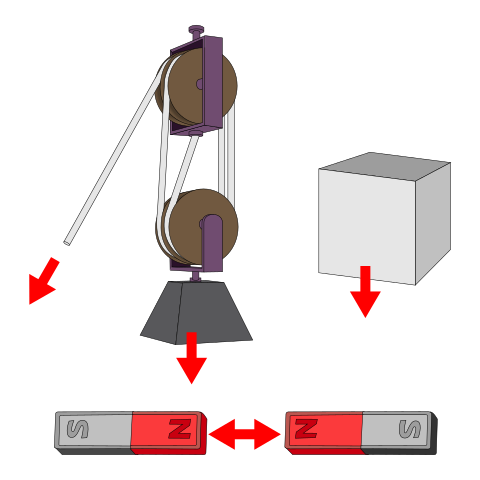Law of Inertia, also known as Newton’s First Law of Motion, that forms the basis for understanding motion. This law describes the natural tendency of objects to resist changes in their state of motion or rest. Following are the different conditions:-
On inclined plane (i) moving down an inclined plane accelerate , whereas (ii) moving up retard, motion in horizontal plane is an intermediate situation . Galileo concluded that an object moving on a frictionless horizontal plane must neither have acceleration nor retardation, It should move with constant velocity
On double inclined plane, a ball released from rest on one of the planes rolls down and climbs up the other. If the plane are smooth , the final height of the ball is nearly the same as the initial height (a little less but never greater). In the ideal situation, when friction is absent , the final height of the balls is the same as its initial height. It does not depend on the shape of inclined.
If the net external force is zero a body at rest continues to remain at rest and a body in motion continues to move with a uniform velocity. This property of is called inertia. Inertia means ‘resistance to change’. A body does not change its state of rest or uniform motion , unless an external force compels it to change that state.

What is the Law of Inertia?
Law of Inertia states:
“An object remains in its state of rest or uniform motion in a straight line unless acted upon by an external force.”
That objects have a natural resistance to changes in their state. If an object is at rest, it will stay at rest, or if it is moving at a constant velocity, it will continue the same direction unless an external force compels it to change.

Why its called the Law of Inertia?
The term inertia comes from the Latin word iners, meaning “lazy” or “inactive.” Inertia is the property of matter that resists changes in state. The greater the mass of an object, the greater will be its inertia.
A small ball can be pushed easily because it has less inertia.
A heavy rock, requires great effort to move or stop because of its high inertia.
Examples :-
1.Stationary Objects: A book lying on a table. The book remains stationary unless someone applies a force to move it. This happened because of the book’s inertia and keeps it at rest.
2. Moving Objects: A ball rolling on a smooth surface, with no friction or air resistance, the ball would continue to roll indefinitely at a constant speed. But, in real-life, external forces like friction and air resistance will slow it down.
3 Car and Passengers: When a car suddenly stops, passengers tilt forward. This happens because their bodies, in motion along with the car, resist the sudden change (stopping). Seat belts are designed to counteract this inertia and prevent injury.
Types of Inertia
1.Inertia of Rest: This is the tendency of an object to remain at rest unless acted upon by a force.
Example: A stationary football remains in place until kicked.
2. Inertia of Motion: This is the tendency of a moving object to keep moving unless a force slows it down.
Example: A cyclist go downhill keeps moving until friction or brakes stop the motion.
3. Inertia of Direction: This is the tendency of an object to maintain its direction of motion unless a force changes it.
Example: A car taking a sharp turn requires force to alter its straight-line motion.

Mathematical view :-
Law of Inertia sets the stage for Newton’s Second Law, which tell the relationship between force, mass, and acceleration (F = ma). An object with greater mass resists acceleration more due to its higher inertia.

Importance of the Law of Inertia
1.Daily Life Applications:
Seat belts and airbags in vehicles protect us by countering inertia.
Sports strategies often use the principles of inertia to control motion.
2. Foundation for Mechanics: It helps us to understand the motion of celestial bodies, vehicles, and even microscopic particles.
3. Technological Advances: Knowledge of inertia has enabled us to know like advanced braking systems, roller, and space exploration technologies
Note :-
Law of Inertia is a simple and the natural behavior of objects. It explain that motion or rest is not arbitrary but governed by forces and properties of matter. This principle helps us to make sense in science and technology. Law of Inertia give idea about the forces and interactions about the shape of our universe.
Law of Inertia, also known as Newton’s First Law of Motion, states that an object will remain at rest or in uniform motion in a straight line unless acted upon by an external force. It describes the natural tendency of objects to resist changes in their state of motion.
Because it explains the property of inertia the resistance of an object to any change in its state of rest or motion. The term inertia is derived from the Latin word iners, meaning “lazy” or “inactive.”
Three types of inertia are:
1.Inertia of Rest: The tendency of an object to stay at rest.
2. Inertia of Motion: The tendency of an object to maintain its motion.
2. Inertia of Direction: The tendency of an object to maintain its direction of motion.
2 thoughts on “Law of Inertia”